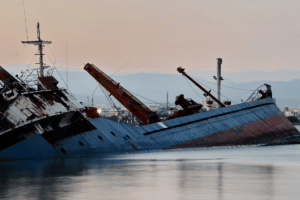There are a multitude of reasons that a vessel can sink. However, a lot of the causes are completely preventable as long as vessel owners and other responsible parties take all required and necessary actions and precautions. Unfortunately, this isn’t always the case, and in turn, numerous maritime workers and even ship guests and passengers have been injured and/or killed because of the sheer negligence on part of employers, captains, and vessel owners. In cases in which negligence and carelessness led to accidents and injuries, the negligent party is typically responsible for the compensatory damages that follow.

Common Causes for Negligent Vessel Sinkings
Under general maritime law, seaman must be afforded a safe, seaworthy vessel while on the job. When these rights are taken away, a host of issues can occur that can lead to the sinking of a vessel. The most common causes of these sinkings in regards to maritime work include:
- Navigational and steering mistakes
- Failure to make repairs to a vessel beforehand
- Leaking parts, such as the lazarette, propellor, or stuffing box
- Undertrained or improperly trained crew members
- Failure to adequately and safely store cargo
- Fires and/or explosions
- Lack of watertight doors, holds, and covers
- Failure to listen to warnings regarding severe weather
Fatal Example of Negligence and Vessel Sinkings
On January 13, 2012, the cruise ship Costa Concordia was sailing off the shore of the Italian Isola de Giglio during a seven-day cruise in the Mediterranean when it hit a rocky reef in shallow waters. The ship’s captain, Francesco Schettino, claimed to be familiar with the local waters and took the ship off its programmed route to give a foghorn salute to the local islanders. The resulting gash allowed water to flood the engine room, and the ship lost control when the power went out. Hours later, after drifting and listing to one side, the Costa Concordia rolled on its port side and partially sank. Captain Schettino, who abandoned ship before the passengers and crew were safely disembarked, was put on trial for negligence, manslaughter, and abandoning ship. 32 persons died and 64 were wounded.
The Costa Concordia disaster made international news headlines in 2012, but it was only of many maritime accidents that resulted in sinkings. Two days later, the tanker Edime sank off the Albanian coast after it exploded. One seaman died, and two were reported missing.
Other recent sinkings include:
- July 10, 2013: A Chinese freighter, the Harmony, collided with a Greek ship, the Blessing, in the Yellow Sea off the coast of South Korea. A navigational error caused the collision.
- August 16, 2013: The St. Thomas Aquinas, a 40-year-old Philippine ferry, collided with the Sulpicio Express Siete and sank. 55 persons were killed. Negligence and poor navigation were cited as possible causes.
Compensation in Vessel Sinking Accidents
If passengers or crew are injured or killed in an accident that results in a vessel sinking, maritime law allows for compensation under the Jones and Death on the High Seas Act. If the incident occurs on overseas on a non-U.S.-flagged ship, local maritime courts also allow for compensation. Generally, compensation is given to cover the costs of rehabilitation, present and future medical treatment, current and expected lost wages, in addition to pain and suffering and survivors’ benefits.